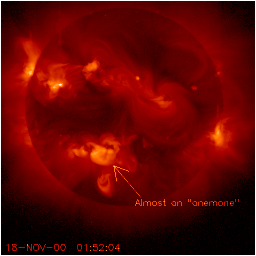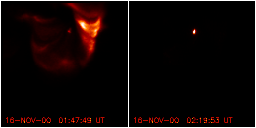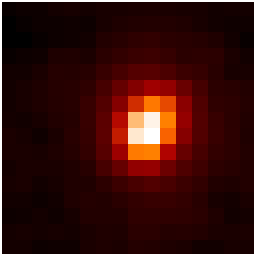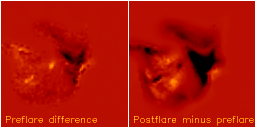
Solar active regions sometimes emerge in coronal holes (see a recent nugget for an example of a "gorgeous" coronal hole). When this happens, the new active region may not appear to have any coronal connections to other magnetic concentrations. Nowadays we call this an "anemone" region, after the windflower; in bygone eras the terms "rosette" and "fountain" were also used. These terms don't describe what we think is going on, they describe what we see. Here's a recent anemone:

It's not the most perfect of anemones, but you will get some further ideas about these things from our earlier nuggets on the subject ([1], ([2]).
As perhaps may not be so unusual (see [1]), an extremely compact and short-lived solar flare occurred smack dab in the middle of this anemone:

A better feeling for the compactness of this flare would come from this close_up view:

which is only (you can count them) 16 pixels across, a mere 32,000 km on the Sun, but more than twice the diameter of Earth! The flare itself is barely resolved and is therefore a good example of a point source useful perhaps for testing the SXT optics. In other words, the few pixels that brightened don't hint strongly of the underlying structure; probably a compact loop resulting from recently emerged magnetic flux; possibly with its direction of concavity towards the upper left.
The neat thing about this compact flare, buried in the heart of its anemone, is that it seemed to have jostled the whole anemone structure. Or perhaps vice-versa. The difference images below show the result of that:

"Preflare" shows a bright dot in the geometric center of the structure, the very beginning of the flare brightening; the dark dot at that position in the "postflare minus preflare" image shows that the flare is over and done with. The interesting thing is the dimming (dark regions) at the periphery during this process. It seems that the global structure of this active region may have varied during (because of? causing?) the flare.
January 19, 2001